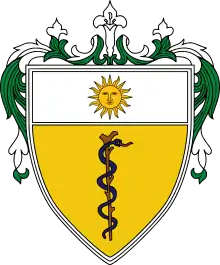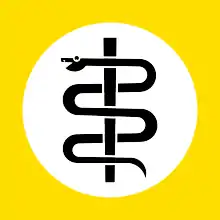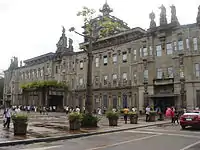University of Santo Tomas Faculty of Medicine and Surgery
The University of Santo Tomas Faculty of Medicine and Surgery (simply "UST-Medicine" or "UST-Med") is the medical school of the University of Santo Tomas, the oldest and largest Catholic university in Manila, Philippines.
 | |
Former names | 1871 – Faculty of Medicine and Pharmacy |
|---|---|
| Established | 1871 |
| Dean | Ma. Lourdes Domingo-Maglinao, M.D. |
| Regent | Rev. Fr. Angel A. Aparicio, OP |
| Students | 2,072 (as of 2016)[1] |
| Location | St. Martin de Porres Building, UST, Sampaloc, Manila, Philippines |
| Patron saint | Saints Cosmas and Damian |
| Colors | Yellow |
| Website | med |
 | |
Established in 1871, the faculty is the first medical school in the Philippines. It is proclaimed to be a Center of Excellence by the Commission on Higher Education.
History

Petition for the establishment of colleges dedicated to medicine and pharmacy started in 1682,[2] 61 years after the foundation of the University of Santo Tomas. On November 22 of the same year, the Spanish granted the petition but nothing came of it due to financial and technical difficulties. By 1785, the Dominican Friars put it on the priority list and despite the enthusiasm of Governor General Mariano Folgueras, the planned colleges failed to materialize until the late 19th century.
The Faculty of Medicine and Surgery was founded in 1871[3] by virtue of the modified Moret Decree of 1870 which supplants the Philippine educational reforms of 1865 by the Spanish Government.[4] The original Moret Decree calls for the secularization of the University to be renamed as "Universidad de Filipinas,"[4] Upon the protests of religious groups, parents and the Archdiocese of Manila, the decree was modified to remove the inimical provisions. The modified decree was approved and promulgated in October 29, 1875 by the Governor General of the Islands, Don Rafael Izquierdo.[4]
The Faculty of Medicine was eventually associated with Colegio de San Jose as both were suffering from lack of financial support. Both institutions were saved by Dr. Esteban Rodriguez de Figueroa's last will and testament which stated that his wealth be given to the Society of Jesus.[2] The haciendas of Colegio de San Jose were turned over to the University of Santo Tomas as ordered by Governor General Domingo Moriones y Muralla in 1879. These were returned to the Society of Jesus in 1910 which was to fund a seminary now known as the San Jose Seminary.
It was also associated with the San Juan de Dios Hospital which functioned as the college's clinical arm as decreed by King Alfonso of Spain on October 29, 1875.[2] This setup continued until 1941 when the Japanese took over Quezon Institute and transferring all of its medical staff and patients to San Juan de Dios Hospital. Clinical training during this time was in partnership with Saint Paul Hospital in Intramuros until the walled city's destruction during the Liberation of Manila.
With the reopening of the Faculty of Medicine in España, it experienced substantial growth. In 1932, the Faculty began to accept female students and by 1937, about 30 women physicians were graduated.[2]
The Faculty consistently ranks among the top performing medical schools in the country. The UST Faculty of Medicine and Surgery has also produced the largest number of competent, compassionate and committed medical doctors in Philippine history.[3]
Notable Personalities
Jose Rizal, the national hero of the Philippines, enrolled in the Faculty to pursue foundational courses in medicine. He pursued further studies in Ophthalmology at Madrid Central University (now Complutense University of Madrid), the University of Paris, and the University of Heidelberg in Germany.[5]
Program design and delivery
The Faculty offers the four-year Doctor of Medicine (M.D.) degree, a comprehensive professional academic program which combines lectures, case analyses, and practical simulation exercises. The entire curriculum focuses on the basic, clinical, and emergency medical sciences. Teaching methods make use of both classic and modern medical practices and technologies.The Faculty is also proud of its extensive learning facilities like the LRU T3Net connection opened in 2004, Electron microscopy unit, multimedia lecture halls, extensive journal collection, wireless-mesh and the Center for Health Science Research.[6]
In 2001, the Faculty adopted the problem-based learning method for use in the curriculum.[7] The move was highly controversial. Several professors complained that the medical students were not learning the basic sciences adequately. In 2003, the curriculum format combined elements of both traditional (lecture-based) and problem-based methods.Contrary to what was expected as a decline in the quality of the learning of students by some faculty members the first and second batches of PBL trained physicians garnered a 92 & 96% passing percentages, respectively. This data complemented the 10-year study on outcome improvements using PBL conducted at Harvard School of Medicine from 1994 to 2004.[6]
The Faculty is distinct from other medical schools in its policy of requiring graduating students to undergo a series of written and oral exams known as the revalida, a qualifying examination prior to graduation practiced since 1871. In the oral exams, groups of three students each are questioned by panels composed of three professors on basic, clinical, and emergency medical sciences. Passing the revalida is a prerequisite to graduation. Medical school graduates qualify to take the licensure exams for physicians conducted by the Board of Medicine, and under the control and supervision of the Professional Regulation Commission of the Philippines.[6]
Academic programs
The Faculty offers the following professional academic programs:[3]
- Doctor of Medicine
- Master in Clinical Audiology
- Master of Science in Pain Management
- Master in Public Health (International) ladderised program with the University of Leeds, UK
The Faculty regularly conducts postgraduate courses covering specialties and subspecialties in Medicine and Surgery (i.e. Sports Medicine, Family Medicine, Geriatrics and Gerontology, Alternative Medicine, etc.).[3]
Faculty Departments
- Anatomy
- Anesthesiology and Perioperative Medicine
- Biochemistry, Molecular Biology and Nutrition
- Medical Ethics
- Clinical Epidemiology
- Clinical Neurosciences and Behavioral Medicine
- Dermatology
- Laboratory Medicine
- Legal Medicine
- Medical Education
- Medicine
- Obstetrics and Gynecology
- Ophthalmology
- Otorhinolaryngology
- Pathology
- Pediatrics
- Pharmacology
- Physiology
- Preventive, Family and Community Medicine
- Radiology
- Physical Medicine and Rehabilitation
- Surgery
Performance
The Faculty is proclaimed Center of Excellence[8] in the field of medical sciences by the Commission on Higher Education.
It has been producing several topnotchers[9] in the national licensure exams for Filipino doctors and enjoyed its LEVEL II accreditation from PAASCU recently. It is also the alma mater of several Secretaries of Health of the Philippines[10] and several Presidents of the Philippine Medical Association,[11] the largest organization of medical doctors in the country. The Faculty has also produced numerous hospital administrators, medical directors, clinical specialists & scientists, and medical professors in the Philippines and abroad. The Faculty garnered a passing rate of 99% in the Physician's Licensure Exam held last August 2009 and August 2010.[12] The Faculty was also ranked as the only Asian medical school to be in the top 10 list of foreign medical institutions by the U.S. Educational Commission for Foreign Medical Graduates in 2007.
Reputation
The Faculty is widely regarded in medical, educational, and social circles as the premier medical school in the country.[13]
Facilities
The Faculty draws physical and manpower resources from its training institution, the University of Santo Tomas Hospital, popularly known as the UST Hospital. The hospital is one of the largest fully equipped medical facilities in the country.[14]
Several autonomous units of the University of Santo Tomas provide allied faculty and research support, such as:[15]
- The UST Graduate School - Center of Excellence in Chemistry[8]
- The UST Faculty of Pharmacy - Top Performing Pharmacy and Medical Technology School in the licensure examinations[16]
- The UST College of Nursing - Top Performing Nursing School in the licensure examinations and Center of Excellence in Nursing[8]
- The UST College of Rehabilitation Sciences - Top Performing Physical and Occupational Therapy School in the licensure examinations[16] and Center of Development in Physical Therapy
- The UST College of Science - Center of Excellence in Chemistry,[8] Center of Excellence in Biology,[8] and Center of Excellence in Psychology[8]
- The UST College of Education- Producer of Biological Science Majors (Bachelor of Secondary Education program); Top Performing School in the Licensure Examination for Teachers; Level III Accreditation from PACUCOA (Bachelor of Elementary Education and Bachelor of Secondary Education programs); and Center of Excellence in Teacher Education (June 2, 2008 - June 2, 2011)
References
- Bulauan, J.A.A. & Garcia, J.C.V. (2011-01-26). "Too many students, so few classrooms". The Varsitarian. Retrieved 2011-06-06.
- Dayrit, C., P. D. S. Ocampo, E.R. de la Cruz (2002). "History of Philippine Medicine 1899-1999 with Landmarks in World Medical History." Manila: Anvil Publishing
- Official prospectus, UST Faculty of Medicine and Surgery, 2006.
- Rodriguez, L. OP (1971). A Century of Progress or The First One Hundred Years of the Faculty of Pharmacy of the University of Santo Tomas Dedicated to the Service of the Nation Through Pharmaceutical Education. Manila: unpublished thesis
- Gregorio F. Zaide. The Life, Works, and Writings of Jose Rizal. National Book Store Inc., 2003.
- Academic programs, UST Faculty of Medicine and Surgery, 2006.
- Med students now approve PBL Archived 2007-09-28 at the Wayback Machine The Varsitarian. Vol. LXXIV, No. 2 • July 10, 2002
- List of Centers of Excellence and Centers of Development, Commission on Higher Education (CHED), Republic of the Philippines, 2007.
- Statistical Data of Board Examination Passing Rates, Physician Licensure Examinations, Professional Regulation Commission, 1997-2006.
- History, Department of Health (DOH), Republic of the Philippines, 2007.
- History, Philippine Medical Association, 2007.
- Alumni list, UST Faculty of Medicine and Surgery, 2007.
- Annual Conference Report, Philippine Medical Association, 2005.
- Facilities, University of Santo Tomas, 2007.
- Autonomous faculties and colleges, University of Santo Tomas, 2007.
- Statistical Data of Board Examination Passing Rates, Professional Regulation Commission, 1997-2006.

